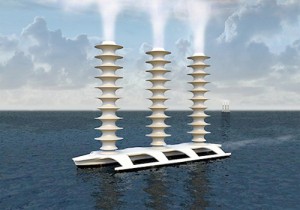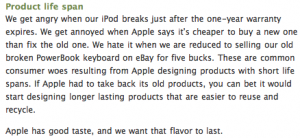“Yet the bill has no chance unless President Obama steps up. Mr. Obama pledged to “engage” with the Senate to pass a comprehensive energy and climate bill “this year.” This was one of those ticket-punching statements that isn’t going to change any minds. What he should have said is that he is going to hammer on the Senate until it does what this country needs.” -NYT Editorial, May 14, 2010
The Kerry-Boxer climate bill has finally “rolled” into the Senate for serious consideration. I’d like to think that the recent oil spill in the Gulf put enough pressure on elected officials to cut our dependence on fossil-fuels. I’d like to think that the bill will actually get through the Republican road blocks in the Senate. The fact is, time is running out for wishful thinking. President Obama and the EPA need to realize this, and assume leadership positions on this issue.
There is a glimmer of hope on the horizon: the Washinton Post recently reported that the EPA is “moving forward with carbon regulation,” which could be used as leverage. Industry would rather have a fairly pro-industry climate bill, than strict EPA regulation, so they might ease up their lobbying campaigns. Whether this is optimal, I don’t know. I do know that some type of regulation is better than nothing at all.
As a closing personal note to all of my K2C blog posts, I would like to share how important this climate change issue has been to my understanding of the US public policy process. Next year I will be attending a master’s program in public policy, hopefully to learn more about navigating our policy maze.
In my blog post entitled “Professor Klaus is Coming to Town” I wrote about a concept in which artificial trees would be used to sequester carbon. With my limited scope on climate change, I found it to be a pretty fascinating read. The notion of capturing carbon in these fields of artificial trees was a concept that I thought was ahead of its time. Until, I came across this article on a tech blog I frequent often, Gizmodo.
The technology is being funded by former Microsoft founder Bill Gates (in the same week he also gave 100,000 dollars to ultrasound contraceptives–weird combination, eh?) A company called Silver Lining has built a device that sits in the ocean and spews tons of water into the air, creating a bank of clouds that would reflect the suns rays from the earth. According to the company it would need 1,900 ships to actually stop Climate Change and an additional 7 billion dollars in funding. Surely Wild Bill won’t mind slapping down another 6 billion dollars into the project. While this seems to be a step in the right direction perhaps, it is not absent of controversy.
Citing the lack of movement toward a binding agreement of any sort at the Copenhagen accord, they are moving forward with the project despite their not being any laws of using technology that would alter weather patterns. The team at Silver Lining claims that while constituents continually drag their feet, emission levels are continuing to rise and thus feel as though they have a civic duty to continue forward with the project. The article mentions Klaus’ idea of carbon sequestering trees but goes on to talk about launching rockets to release millions of mirrors into the stratosphere. Surely a public can support ships that create clouds rather than rockets that launch mirrors.
While this perhaps does not have as much controversy of the large hadron collider it still has the potential to send right-winged media in addition to politicians into a tiff–the device has already been termed a “weather altering device.” However, if Silver Lining’s experiment works around, it will alter things for the better.
Funding is obviously going to become an issue as more of these devices are needed. But, why is money an issue when it comes to our existence on this planet? Without life, there is no need for money. When I was in elementary school and talks of the amount of fresh water left on earth were already happening, I asked my parents why they couldn’t just filter the salt water. “Money,” said my father. Money? Seriously? We are actually going to let the “money is the root of all evil” saying win? Say it ain’t so. It certainly hasn’t changed Bill Gates as he continues to deliver these philanthropic gifts to projects he is passionate about. Why let it destroy us? As the world ends are we all going to be hoarding the money we’ve stored under our mattresses? Absolute ignorance will kill us–we need to educate the populace on what exactly these things mean in the simplest of terms and not let the media saturate with its filters.
Sources:http://technology.timesonline.co.uk/tol/news/tech_and_web/article7120011.ece
http://gizmodo.com/5536139/artificial-clouds-that-could-stop-climate-change-receive-investment-from-bill-gates
Tags: Carbon Sequestering, Carbon Trees, Clouds, Klaus Lachner, Large Hadron Collider
An All Consuming Society
In my previous blog post I talked about becoming more aware of the mass consumer society in which the entire world is a part of after the Copenhagen accord. This happened in two ways: one, seeing the amount of brochures that were consumed at the conference and two, seeing the craze created with electronic product cycles. Since I’ve probably got Dickinson College BANNED from ever coming back to the any COP (just kidding) I’ll focus on consumer consumption in this blogpost–particularly product cycles and how the combined advertisement saturation by Madison Avenue and corporations creates unsustainable demand among consumers.
In one of our many discussions in Copenhagen, the 15 of us were in our small kitchen in the Hotel Loven talking about a variety of different things. I, the videographer for these meetings had a unique perspective on things. Sometimes I’d tape stealthy–sometimes out in the open, but usually it didn’t matter what exactly was being taped–people generally spoke their minds. One particular evening, the topic of consumer product cycles came up. Brett Cassette, as he likes to be called, spoke about televisions and how that every year a new processor or doodad will be implemented into a television set that makes the new one irrelevant. Thus, the product that the Smith family just picked up from Big Blue Box retailer only a mere 6 months ago is out of date. It still functions well–just not AS well as the newer television. This was a big issue when desktop PCs were popular. If one would go to out to buy a new computer, 18 months from that time a computer with double the processing ability comes out–this is Moore’s law in effect. It is unavoidable–and just how the industry works. This product cycle created a mass hysteria with people who were once not be considered the mainstream market. These were people who update their desktop towers on a 6 month basis when a new video card hit the market or a new processor. Over the last decade or so, this has translated onto the mainstream market–perhaps video game consoles being the first signs of this happening. Video game consoles have a six year lifecycle–advertising blitzes create mass hysteria and incite demand. Consumers line up outside of retail stores to buy them and replace the previous product in the lineup. Not too sustainable, but a six year product lifecycle is the average.

Fast forward to 2007 and we have the launch of Apple’s darling, the iPhone. The product is launched to a feverish crowd at an outrageous price of 599 dollars. The mass gobbles it up. On to 2008–Apple launches the iPhone 3G. Early iPhone adopters are angry because their product is now out of date. Forums are filled with posters trying to finagle their way out of their contract or trick Apple Support agents into giving them the new iPhone. The iPhone 3G becomes one of the fastest selling products in history. Fast forward to 2009, and the iPhone 3GS launches. Now, the iPhone 3G owners are angry as this iPhone is advertised as being the fastest and most powerful iPhone yet. With the iPhone 4’s release imminent, this vicious consumer craze is likely to happen again.
Perhaps the best question to ask is–whose fault is it? We will use Apple as an example again. Apple knows their products sell themselves. They know consumers pine for anything containing their logo and design finesse. Greenpeace created an iPoison website about Apple back in 2005. They’ve even adapted to numerous demands by Greenpeace to take some of the worst chemicals out of their products:
“Apple has declared a phase out ofthe worst chemicals in its product range, Brominated Fire Retardants(BFRs) and Polyvinyl Chloride (PVC) by 2008. Way to go Steve.”
Yes, Apple is doing everything possible to curtail their environmental footprint. What needs to happen though? One would think that the economy at its lowest would silence this kind of consumer behavior. No. High end electronics are selling just as well. Companies need to make money. Extending a product’s lifecycle means lower revenue streams.
Consumers need to silence that inherent desire in them to have “the latest and greatest.” As a technophile, it is something that I’ve suffered with for quite some time. Slowing down our buying processes will force companies to alter their production habits–perhaps from a year to a year and a half. But when people are breaking their cell phone contracts to buy new phones it sends a message to the herders that the flock is continually getting easier to be manipulated. We need to be green consumers–and not the green that Madison Avenue is talking about. They have commodified green–selling bags, shirts, water bottles and other green products. While this is surely a major improvement from prior years, the primary objective of consumers should be to curtail their own desires and that little voice inside that says “buy buy buy, must have.” Corporations will always be producing and selling new and exciting products but the responsibility has to lie in the new, sustainable consumer to get over appearing outdated in lieu of being glitzy. Being sustainable has to become the new sexy.
Tags: Apple, consumerism, Green
Post-Copenhagen Thoughts
Well, we are a few months removed from the Copenhagen accord and I have yet to offer my feedback as to what I actually thought about how things went down in Denmark. I’ve delayed this for a few reasons:
1. The bombardment of information: so many numerous things happening over there to actually conclude that anything actually went on.
2.Overall awe of the event: As many of my classmates detailed in their posts being at the conference was surreal. So many people, from so many different countries–I’m not sure I’ll ever be in a room with that kind of arena ever again.

3.My limited knowledge on the subject waited until the Media sorted it out in a numerous ways so I could come to an educated conclusion.
And I still haven’t. Between the glitz and the glamour of the streets of Copenhagen, to the Ikeaness of the Hotel Loven, to the glowing signs of Hopenhagen no REAL answer has come out of the accord. From what I have gathered, the message sent by the delegates was ONWARD to Cancun, the location of the COP16 (along with high schoolers and college students on winter break–I’m sure the delegates from China will enjoy partying up with Joe Sixpack). So, basically we had a conference about what to do at the next conference. Exciting. No legally binding agreement. Nothing. Observation of an outside document by the UNFCCC and a few billion dollars towards resources. Hooray.
While many may deny that the UEA e-mail link had anything to do with the conference being a bust, I think it did. The American people, at least the way the image the media sent, were gung-ho for fighting climate change. Then FoxNews reports on this e-mail link stating that statistic were not as accurate as people once thought, etc. etc. Media blows up, right-wing America says “hey now, wait a minute, you mean we were right all along.” BLAM. We are sent back to the 1980s. As my wise bubbie would say, “Oy Veys Mir.”
However, not all was lost. For the people who attended the conference for the first time their were minds were surely changed. It was empowering to see such a strong Youth presence at the event, with some of my classmates getting down to their skivvies to protest climate change. Groups passing out how old will you be in 2050 shirts, protesting all around the conference center in order to create media spectacles and perhaps mute the fire that was the right-wing media. Some of my classmates gave up meat after learning of its carbon footprint, some fasted in protest–some have decided to pursue careers in the climate change field.
Me? Well, I did none of those things.When I came to Copenhagen I had already stopped eating meat and pork products. Check one. My career path has been made up since middle school (working in Professional Wrestling in some capacity), and I’m Jewish–we fast for religious purposes. Check two and three So, how did this whole climate change affect me personally? Well, I can say that it I have considered the environment when doing my daily activities–I’d be lying. Perhaps I am more conscious of them, and I’m trying to break some old habits but no one is perfect. I think I am more aware of a consumer level–since that is my main area of study. One thing that I found kind of contradictory with the conference was the millions of pamphlets and papers that were handed out at the conference. Why not get into a partnership with Apple or another handheld corporation to rent iPod touches out to registered delegations and have them be turned in at the end of the conference. Perhaps this isn’t practical–but I could make a separate documentary about how unsustainable the COP15 was–considering the amount of fuel it took to get the delegations there and back, the amount of papers that were printed for the event, and the numerous amount of them I saw thrown onto the floor. If we are not looking for alternatives at the level in which alternatives are supposed to be discussed how are we supposed to become a more sustainable world when the conference itself is not sustainable. Many will find that statement controversial, but hey, controversy creates cash, or in this case WASTE.
Tags: controversy, Copenhagen, scandal, UEA, waste, youth
Phil Rothrock, Maria Mei and I interviewed President Durden before leaving Carlisle to find out what his opinion was on the work that the K2C research team has done so far, and his perspectives on our role at the conference. You can check the entire interview in the video below.
Tags: climate change education, Dickinson College, Kyoto to Copenhagen





Your Comments